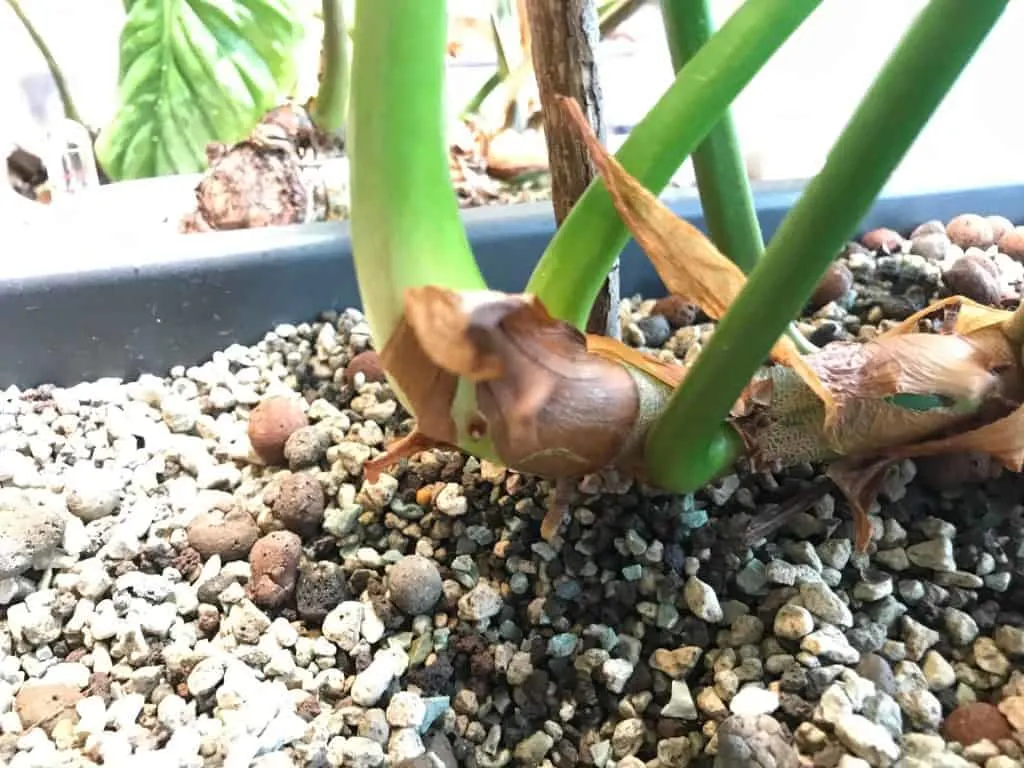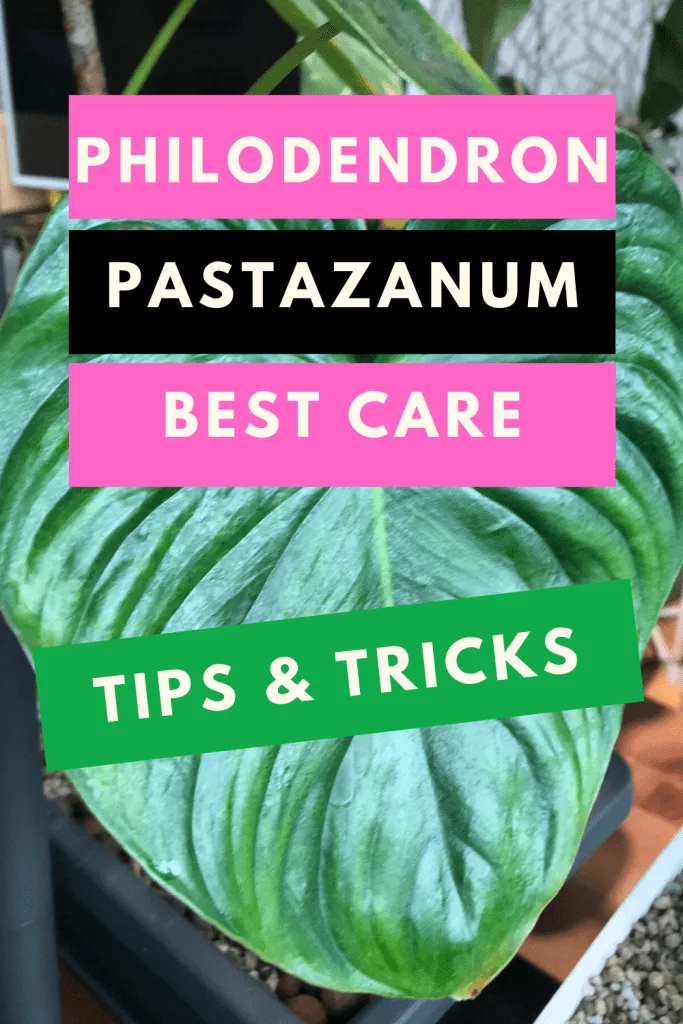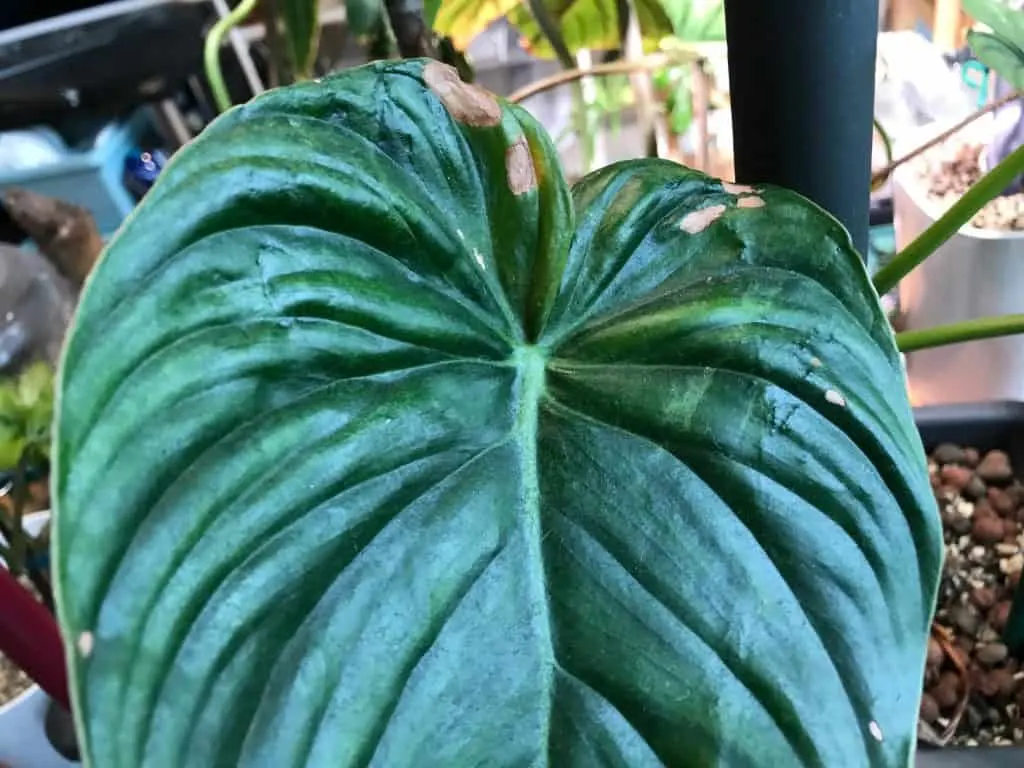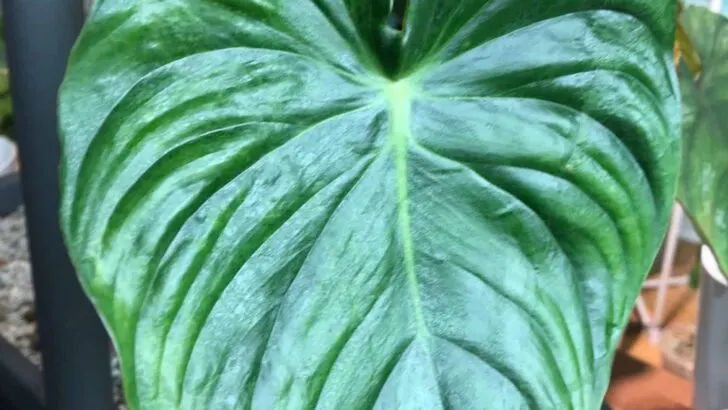It originates from Ecuador from a state called Pastaza where it was collected in the 70’s.
This plant is a crawler meaning that the main stem or rhizome is growing vertically and not horizontally. The petioles are growing vertically from the stem and carry the leaves.
The rhizome should not be submerged and stay on the soil surface as this is where the leaves are emerging. Burying it may lead to rot and a decaying plant.
This is one of the most common mistakes in Philodendron pastazanum care. Rhizomes of crawlers should not be buried in the soil.

Closeup of a Philodendron Pastazanum rhizome
I am growing many different heartshaped Philodendron such as Philodendron Mamei, Philodendron plowmanii, Philodendron gloriosum, Philodendron verrucosum as well as Philodendron Dean McDowell and Philodendron Sodiroi.
All of this Philodendron are absolutely stunning and among my favorite plants overall. However, the Philodendron pastazanum is special. Its extremely green and glossy leaf texture, the size the leaves will get are just breathtaking.
Unfortunately, not a lot of information is present regarding Philodendron pastazanum care.
I, therefore, wanted to take the time to summarize how I care for this beautiful aroid plant. My goal is that this plant is not only doing ok but thriving for you.
Without further ado, let’s highlight the most important aspects of Philodendron pastazanum care.
Table of Contents

Philodendron Pastazanum Plant Care Guide
Soil
Philodendron pastazanum care requires free-draining soil. An aroid mix is best. The potting mix needs to be airy and consist of chunky material such as orchid bark that will allow the water to drain quickly.
The potting soil also needs ingredients that can hold moisture and nutrients such as perlite or pumice as well as soil itself.
Read our article about well-draining soil mixes to learn more about the best ingredients to use.
I personally use Lechuza Pon which is a soilless mineral substrate that contains zeolite. My Philodendron pastazanum loves it and grows really well in this substrate.
The pH level should be kept between 5-7 for ideal soil conditions.
Light
These plants require medium to bright indirect light. If acclimated to it they can take a few hours of direct sunlight in the morning.
The amount of direct sunlight should not surpass a couple of hours and strong afternoon sun needs to be avoided. Otherwise, leaves are burnt and damaged in the worst case.
I keep my Philodendron pastazanum in an east-facing window with a couple of hours of direct sunlight and then bright indirect light for a good part of the day.
Our article about light levels for plants explains the light condition for different window directions in detail.
Watering
Water when the soil is slightly dry. A good rule of thumb is once a week. However, the amount of watering needed per week will depend on many different factors in your home.
The amount of light, humidity as well as temperature and the potting soil used will influence how often watering is needed.
Be careful to not overwater these plants as they will not appreciate staying wet for too long. Make also sure to not let the soil dry out completely.
To keep Philodendron pastazanum care easy and have a happy plant I greatly advice you to use
Temperature
An ideal temperature range for Philodendron pastazanum care is 45°F to 95°F (7°C – 35°C). Night temperatures should be between 60°F to 70°F (16°C – 21°C).
Philodendron pastazanum grows in USDA hardiness zone 11 according to the United States Department of Agriculture plant hardiness zones.
Humidity
Philodendron pastazanum care is most successful in humidity above 65%. Generally, a humidity of 65% – 75% is a great range for these plants.
But do not worry if these conditions are not present in your home. There are different tips and tricks to get to good level of humidity.
Humidity Tip #1: Put your houseplants closely together to create a microclimate with higher humidity, The closer you houseplants are placed the higher the natural humidity around your plants will be.
Humidity Tip #2: The good old pebble tray. Use a tray beneath the pot of your plant and fill it with water. The water will evaporate and increase the humidity around your plant from the bottom.
Humidity Tip #3: Make use of a humidifier that you can set between 65% – 75%. This is a great way to increase the humidity in a room although it is the priciest.
Fertilizer
Use a well-balanced fertilizer at half the suggested strength for your potted Pastazanum plant. You can either use a liquid fertilizer or a slow-release fertilizer.
In our guide about fertilization, you can learn the essentials about fertilizing your houseplants the right way.
Fertilize your Philodendron in spring and summer during the growing season about once a months and stop fertilizing during autumn and winter months.
Propagation
Propagation can be done via rhizome or stem cuttings. The good thing about Philodendron pastazanum propagation is that when the stem is growing along the soil is that your cutting is already rooted in most cases.
Make sure that your rhizome cutting has at least one node. It can be cut with or without a leaf as both cuttings are viable to turn into a new plant.
Below we will talk about the steps of successful Philodendron pastazanum propagation in more depth.
Growth
Philodendron pastazanum is a creeper and the rhizome grows on top of the soil. New leaf spikes emerge along the rhizome. The growth rate of a Philodendron pastazanum is average at best.
Emerging new leaves take a month or more until they are fully unfurled. You will first see a leaf spike that is expanding vertically.
It will grow longer and longer until it sets out a new leaf that will unfurl. The anticipation of how big the newest leaf will get is always high.
The better the Philodendron pastazanum is rooted in the soil the bigger its new leaves will usually get.
New leaves have a light green color and will darken into a healthy dark green. The leaves of these plants look so stunning that they are a showstopper in every plant collection.
Potting
I advise against using round pots which are the most commonly used pot for potted plants. As Philodendron pastazanum are crawlers and will grow horizontally, they will need space to run.
A rectangular pot is best. They do not need to be very deep but the longer they re the better. A good choice is flower pots for outdoor plants mostly used on balconies.
The pots I am using are from Lechuza and are called Lechuza Delta 10 and 20. These pots have the perfect shape. You do not need to use the exact pots but you will get an idea of what pots are best for Philodendron pastazanum care.
Step by Step Philodendron Pastazanum Propagation
So you got a Pastazanum and you want to know how to propagate it. Well you came the to the right place.
With the below step by step guide I will guide you through every step necessary so your propagation endeavor will be a complete success and no odyssey.
Philodendron propagation is quite easy as is propagating monstera plants as the nodes on your plants clearly indicate where cutting can be taken.
Cuttings are the most common way of propagating a Philodendron pastazanum.
A different way would be the propagation from seeds but for this to be successful you will need to have two Philodendron pastazanum plants flower at the same time to pollinate the plants or at least store the pollen to pollinate once a second plant is at the same stage.
Yet another way would be to micro propagate Philodendron pastazanum but for this, to success you will need laboratory equipment and sterile conditions.
All of this may not be necessary as a simple chop-chop will help you to multiply your plant in no time.
Lets now have a look at the Philodendron pastazanum step-by-step propagation guide:
- Have a look at your plant. Find a section with a node
- Take a pruning shear (stems or rhizomes can be quite thick and hard to cut)
- Disinfect the pruning shear using rubbing alcohol and by holding it under a flame for a few seconds
- Make a clean cut between two nodes.
- You can but you do not need multiple nodes to propagate Philodendron pastazanum successfully
- In a best-case scenario, the section you are cutting has already rooted in the ground. This will speed up the propagation process
- If the cut section has one leaf that is great as well. From my experience leaves sometimes are given up by your plant to use the energy for root production and further growth
- A humid environment will help to maintain a leaf as well
- Once you have made a cutting our some cinnamon on the mother plant as well as on the cut section of the cutting
- Cinnamon acts as a disinfectant and will help to close the wound of your plant and cutting
After these steps are done I see a lot of people wondering what to do next. The next logic next step is to decide what propagation medium you want to use.
Great choices are water, Sphagnum Moss, soil, and perlite. I can tell you how I usually do it and the success rate I would say is close to 100%.
I prefer to choose Sphaghnum Moss. The biggest advantage of Sphagnum moss is its water retention abilities. It can hold up to 8 times its own weight in water according to The Wildlife Trusts website.
The biggest mistake you can make with Sphaghnum Moss is to keep it to wet. No matter if you are using dry or live moss the first thing you will need to do is to let it soak up water.
After the soaking you have to press the Sphagnum Moss very hard in your fist at least 3 times until most of the water is pressed out.
If you are skipping this step your cutting will root as the moss will keep it too wet. As described this can easily be avoided but don’t get me wrong.
It happened to me a couple of times and lead to rotted cuttings. That is so unfortunate and something that I do not want to happen to you.
But why do I prefer Sphaghnum Moss? Simply because there is no other medium where I had a better success rate and where I observed cuttings develop quicker.
Now that you have chosen the medium, you need to decide where to put your cutting. Depending on the size of your cutting I would suggest using a plastic container.
Plastic containers will help you to keep the humidity level up with very little work. You can spray the container when you put your cutting in and close the plastic container with a lid.
This way you will have a humidity level of +90% for weeks. You can open the lid every couple of days to ensure the air does not get stagnant.
So you now have the perfect humidity but what about the best temperature? This is where a heat mat comes into play.
Using a heat mat will ensure it is nice and warm beneath your cutting. This will speed up the propagation process and will make sure that your Philodendron pastazanum cutting develops roots fast.
With these steps and setup I guarantee you that very little can ad will go wrong and the propagation of your Philodendron pastazanum will be as fast as it can get.
What about rooting hormone? You can use it and I did use it a couple of times but I found out that it doesn’t make a very big difference if any difference at all.
The steps and setup I outlined are sufficient to propagate your pasta, you can trust me on this.
Common Problems with Philodendron Pastazanum
Spider Mites

Philodendron Pastazanum leaf with spider mite damage
These are the worst of the worst pests you can get. I have been battling with spider mites on my Philodendron pastazanum for months.
They are close to impossible to see based on my experience. They re not only hiding well in all the crevices of your houseplant but are also extremely small.
Spider mites leave webbings on the leaves and petioles of your Pastazanum and will damage the leaves of your plant.
The leaves will eventually turn yellow and die off. A further sign is damaged leaves holes in the leaves that indicate spider mites.
If you are unsure if your Philodendron pastazanum is infested by spider mites you can read our extensive guide that teaches you everything you need to know about a spider mite infestation and most importantly about how to get rid of these buggers for good.
Mealybugs
Not as bad as spider mites and also easier to spot are mealybugs. They look like little cotton balls and at first glance, you could think that some dust settled on your Philodendron pastazanum.
A single mealybug can lay around 600 eggs and it is essential that you are spotting these pests early. They will stay at a certain spot and will feed on your plant in large numbers.
Mealybugs are a plant sap-sucking type. These are the bugs that drench your plant of the essential nutrients and water.
Eventually, your Philodendron pastazanum might even die due to the infestation. It is therefore important that you do something against mealybugs.
With our article on mealybugs and how to get rid of them, you are off to a good start.
Thrips
Thrips are ugly. These bugs can carry diseases and you can even feel their bite as a human. No wonder you do not want them on your Philodendron pastazanum.
Although I never had them infest any of my plants the stories that are told about them are pretty horrifying. They are about 1mm in length and look like tiny grasshoppers with wings.
They are asexual and will reproduce on their own.
When they feed on your Philodendron pastazanum they offset a toxic called salvia. As said they can transmit multiple viruses and this is what makes them so horrible.
Yellow and wilting leaves with curled leaf tips can be signs of thrip damage.
If you suspect a thrips infestation do not hesitate to jump straight to our article about thrips and the most effective countermeasures.
Scale
Scale is quite common and an infestation is not unlikely on your Philodendron. They look like little slugs and the most common scale is the brown scale. We featured it in a recent plant pest article.
They are feeding off the plant sap and are sucking on the plant. Scale itself does not move much and prefers to stay put.
They are mostly brown, flat, and oval and feel in large amounts. They produce quickly and are hard to spot. As long as the infestation is not really bad the chances of survival are good for your Philodendron pastazanum.
Whiteflies
Of all the described bug species whiteflies are the ones that I dread the least. They are off-putting and can be nasty.
However, they are not too difficult to get rid of and your Philodendron pastazanum is not in real danger to die.
How do you know if you have whiteflies on your plant? The easiest way is to take a leaf and to shake it. The whiteflies will set off and will become airborne.
They are sap suckers as well and will not only be annoying but also are capable to do at least some damage to your Philodendron.
Let’s now have a look at some general tips and tricks to keep your plant happy.
Yellow leaves
Yellow leaves are usually a sign of too much moisture in the soil. If you are watering too often or the water cannot drain quickly enough, your plant will indicate this with yellow leaves.
This for me often is a sign that I should have a look at the roots of my Philodendron as mostly I will already spot root rot that needs to be treated. You can have a look at our Root rot treatment guide.
Brown leaf tips
Infrequent waterings, too little or even too much at times can cause leaf tips to brown on your Philodendron pastazanum.
A brown leaf tip indicates for me that something is not ideal. It doesn’t mean that your plant is severely ill or is going to die but there is certainly something in your Philodendron care that can be improved.
Tips to keep your Philodendron pastazanum problem-free
The best care tips for your Philodendron pastazanum summarized:
- Use a well-draining potting mix using orchid bark, perlite, and some potting soil
- Water about once a week when the soil is about to dry out
- Do put the rhizome (stem) of your Philodendron pastazanum above the soil
- Bright indirect light is best and will lead to big leaf growth
- Check on your plant frequently to spot any problems/diseases early on
Moving on to the most frequently asked questions about the Philodendron pastazanum.
Frequently Asked Questions About Philodendron Pastazanum?
Should I cut the brown tips of my plant?
The brown tips, as well as brown areas on the leaves of your Philodendron, can and should be cut off. This will prevent the areas to expand to the rest of the leaf. Furthermore brown and crispy areas cannot produce any chlorophyll anymore and won’t be of any use for your plant.
Why is my Philodendron pastazanum dying?
There can be many different reasons why a Philodendron pastazanum is dying. It can be overpowered, underwatered, nutrient-deficient or a pest infestation might be the cause. The most likely reason however for a Philodendron to be dying is overwatering. In that case, check on the roots of your plant and remove and decaying or rotting roots.
How often do I need to water a Philodendron pastazanum?
A general rule of thumb is once a week. Water when the soil is just about to dry out but do not let it dry out completely.
What to do with the rhizome?
The rhizome belongs above the soil. Burying it beneath the soil might lead to rot and you risk that your Philodendron pastazanum might die.
Conclusion
Philodendron pastazanum is my favorite heart leaf shaped creeping Philodendron.
The only one that comes close to is the Philodendron Dean McDowell which is a cross between a Philodendron Gloriosum and a Philodendron pastazanum usually written as Philodendron Gloriosum x Philodendron pastazanum.
What I like most is the beautiful green colored leaves that can get massive over time and the relatively easy care.
As long as you are not overdoing the watering and your Philodendron pastazanum is in a chunky airy substrate chances are that it will thrive and that you will have little problems with it.
The hardest part for sure is to actually find a specimen as they are not commonly sold and once one becomes available on Facebook, Instagram, or any webshop for this sake they are quickly gone.
What are your best care tips and tricks for Philodendron pastazanum? Let us know in the comment section below.

Daniel has been a plant enthusiast for over 20 years. He owns hundreds of houseplants and prepares for the chili growing seasons yearly with great anticipation. His favorite plants are plant species in the Araceae family, such as Monstera, Philodendron, and Anthurium. He also loves gardening and is growing hot peppers, tomatoes, and many more vegetables.


